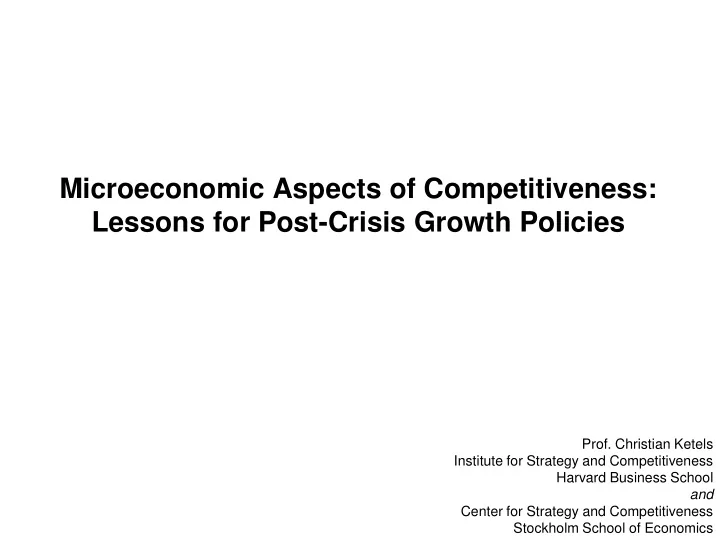

Microeconomic Aspects of Competitiveness: Lessons for Post-Crisis Growth Policies Prof. Christian Ketels Institute for Strategy and Competitiveness Harvard Business School and Center for Strategy and Competitiveness Stockholm School of Economics
Policy Priorities after the Crisis Acute crisis response Exit from emergency measures The quest for growth
Empirical Observations • Many countries have achieved high growth for some periods of time • Few countries have been able to sustain high levels of growth; high growth episodes are often followed by dramatic slow-downs • Episodes of high growth are often preceded by macroeconomic stabilization and (international) market opening • What policies can support sustained growth ?
Growth Spurts and Competitiveness Consumption • Temporary capital inflows • Excessive government spending Productive • Domestic credit bubble capacity • Positive, temporary terms-of-trade GDP = > shock Competitiveness • Macroeconomic Adjustment Time
Perspectives on Economic Growth Strategies Pro-competition Sector-specific Country-specific policies policies policies Framework Yes No No Conditions Competitiveness Yes Yes Yes Policy • Necessary but often not sufficient, at least in the short- to medium-term Industrial No Yes No Policy
Perspectives on Economic Growth Strategies Pro-competition Sector-specific Country-specific policies policies policies Framework Yes No No Conditions Industrial No Yes No Policy • Impact often short-lived and almost always negative in the long-term
Perspectives on Economic Growth Strategies Pro-competition Sector-specific Country-specific policies policies policies Framework Yes No No Conditions Competitiveness Yes Yes Yes Policy Industrial No Yes No Policy
Dimensions of Competitiveness Microeconomic Competitiveness (MICRO) Sophistication Quality of the of Company State of Cluster National Business Operations and Development Environment Strategy Macroeconomic Competitiveness Social Quality of Infrastructure Macroeconomic and Political Policy (MP) Institutions (SIPI) Endowments Natural Geographic Size Resources Location
An Empirical Approach STAGE STAGE STAGE logGDPpc MICRO SIPI MP c,t MICRO c,t SIPI c,t MP c,t 0 1 1 1 STAGE ENDOWMENTS END c,t 1 STAGE year STAGE . t STAGE c c,t t • Data – Broad set of data sources covering all dimensions of the framework – Unit of observation is the average response per indicator, country, and year – Data set is a panel across more than 130 countries and up to 8 years, using the World Economic Forum’s Global Executive Survey • Approach – Step 1: Conduct separate principal components analyses for MICRO, SIPI, to derive their averages per country-year (Simple average for MP) – Step 2: Comprehensive regression of MICRO, SIPI and MP on log GDP per capita with endowment controls and year dummies. • The model allows the coefficients to vary by the stage of development:
Selected Findings • The linear model explains 83% of the variation of GDP per capita across countries • The linear model reveals that each broad competitiveness category matters , even when controlling for the others and for endowments – In contrast, past literature has tended to focus on one dimension and on very long time frames • Weights change by stage of development Linear model High Stage Middle/Low All Economies Stage MICRO 0.35 0.51 0.15 0.53 0.47 0.69 SIPI Macro Policy 0.12 0.02 0.16 1.00 1.00 1.00
The Baltic Countries in the Global Crisis Scenario 1 Scenario 2 Failure of macroeconomic management Additional Additional Challenge Challenge Common Policy Failure Failure to High Openness Upgrade Policy Policy implication implication Shift to new Return to policy approach pre-crisis policy
Overheating Unit Labor Costs, Baltic Countries and Poland, 2000 – 2010e 2000 = 100% 450% 400% Estonia 350% 300% Latvia 250% Lithuania 200% Poland Baltic Sea Region 150% 100% 50% 2000 2001 2002 2003 2004 2005 2006 2007 2008 2009 2010e
Reversal Current Account Balance, Baltic Countries and Poland, 2000 – 2010e Current Account Balance, 15 in % of GDP 10 Baltic Sea Region Latvia 5 Lithuania Estonia 0 Poland -5 -10 -15 -20 -25 2000 2001 2002 2003 2004 2005 2006 2007 2008 2009 2010e
Impact Unemployment, Baltic Countries and Poland, 2000 – 2010e Recorded unemployment rate, % 20 Latvia 18 Lithuania 16 14 Estonia Poland 12 10 8 Baltic Sea Region 6 4 2 0 2000 2001 2002 2003 2004 2005 2006 2007 2008 2009 2010e
Putting the Current Crisis in Perspective • A decade of significant achievements , even taking the painful current losses into account • Clear policy mistakes made in the run-up to the crisis in not avoiding the overheating • Remarkably solid policy response to the crisis
The Profile of Past Policy Reforms Micro Macro Social Infra- Business Company Macroeconomic structure and Pol. Environment Quality Sophistication Policy Institutions Related and Supporting Political Institutions Industries Demand Conditions Rule of Law Context for Strategy Human Development and Rivalry Factor Input Conditions Admin Logistic. Capital Comm. Innov.
The Role of the EU Macroeconomic policy Microeconomic policy • • Euro zone conditions Acquis Communitaire • • Stability and Growth Pact Common Trade, Competition, and Agricultural Policy • Structural Funds, Framework Programs, CIP • Lisbon Agenda PROVIDED • Minimum standards • Reducing weaknesses LACKED • Generic policy targets • Strategic priorities • Creating strengths • Unique objectives
Implications • Sustainable growth depends on a solid mix of micro- and macroeconomic policies • Growth-oriented policies need to contribute to the emergence of competitive advantages and engage the private sector Developing a national economic strategy • What unique advantages does the location offer as a Positioning place to do business; for what activities? • How do policy priorities support the strategy? Developing the capacity of local companies • How do policies facilitate the spreading of best Private Sector practices across companies? Development • How do policies support the upgrading of companies’ competitive advantages?
Recommend
More recommend